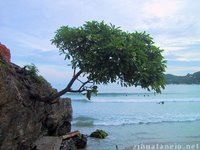Part of what Zihuatanejo is all about is nature and exercise. One used to have to be in reasonably good health to visit here since getting around always involved a lot of walking up and down hills and along footpaths. Now that is no longer true, as is painfully obvious, and in the process we are literally paving paradise to put up parking lots... and roads and walkways to new and mostly luxury lodgings owned by foreigners. Has the standard of living benefitted? Well, I can now buy Dr. Pepper at the supermarket, but the supermarket is putting the hundreds of families who depend on the local produce and farmers' markets out of business. And added to that are the thousands of unskilled and uneducated people who move here looking for free land we don't want to give them and job opportunities that they aren't qualified to fill.
The walkway that sort of makes sense is the one to Playa La Madera called El Andador del Pescador, although it was unnecessary, and visitors and residents had no difficulty getting back and forth decades and even centuries before it was built. It is actually a longer walk than if one walks the "old" route from the museum to the footbridge across from La Mordida pizza and burger joint. And many of us used to always simply cross the lagoon mouth at the beach before it was turned into a polluted canal, and walk along either the dirt path or the top of the rocks on the other side, depending which part of La Madera we wished to reach. Everyone used to walk to the Chololo and the Kau-Kan when they were the first discoteques, both on the beach at La Madera. A few sad-looking mangroves on the other side of the canal from the museum are all that remain of the large and scenic estuary that was stupidly obliterated to build new neighborhoods and a shorter road to La Ropa.
When my wife's parents first visited La Ropa's beach they used to have to get there by canoe from their house on the beach next to the present-day basketball court on the Playa Principal. Eventually the Catalina Hotel built the road out to their location at La Ropa, and later it was extended around behind much of what is left(!) of the coconut grove at La Ropa to reach the Capricho del Rey at the far end of La Ropa Beach. Later that route was shortened by going straight through the coconut grove, which is now being cut down for new luxury homes... mostly owned by foreigners. As soon as that road was paved La Ropa saw endless vehicles speeding through the coconut grove bringing noise, dust and a lot of their garbage to what was once a serene and pristine masterpiece of nature and local social culture.
Along the cliffsides surrounding the bay we used to have thousands of fragrant frangipani trees. With the building of the walkway from downtown to La Madera most of those along that portion have disappeared, some from the construction, some from vandalism and careless people.  Similarly, at Puerto Mio most of the frangipani is gone due to rapacious development for... you guessed it... more luxury homes that are now extending out past Playa Contramar to the northwestern coast of the bay.
Similarly, at Puerto Mio most of the frangipani is gone due to rapacious development for... you guessed it... more luxury homes that are now extending out past Playa Contramar to the northwestern coast of the bay.
In the above photo a frangipani clings to the cliff beside the ruins of what was the popular Chololo disco at La Madera Beach. The damaged walkway seen in the photo has been rebuilt "bigger and better".
At La Ropa Beach we already had one incident a couple of years ago where La Casa Que Canta blasted the rocks of the natural pool called El Pozo del Eslabón to try to keep locals from hanging out at the beginning part of the beach where it has been suggested the walkway should be extended to. Needless to say there was a large local outcry after a local child cut his feet on the sharp rocks Casa Que Canta left in the natural pool and cemented along the rocks there. I guess from a foreigner's point of view it might be desireable to build a walkway since it would inevitably lead to more luxury homes owned by foreigners, but from a Mexican's point of view it seems tragic to lose any more than what's already been lost. Part of the attraction of La Ropa is (or was) its relative isolation from the hustle and bustle of downtown, and Las Gatas is in an even more vulnerable position to lose its culture and identity if a walkway or road were ever built to reach there.

No hay comentarios.:
Publicar un comentario